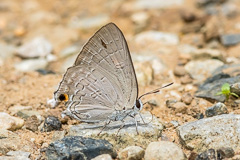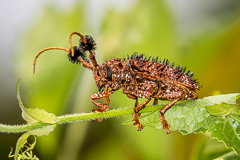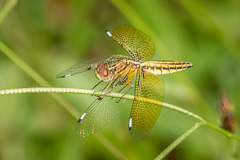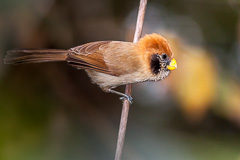Overview
Dates: |
1 - 3 July 2020. |
With Steve Tibbett. With Thailand still officially in a state of emergency, but now emerging from three months of lock down restrictions due to the Covid-19 global pandemic, this was our first trip away from Chiang Mai, other than a short trip to Omkoi last month. With some wildlife sanctuaries and national parks officially open from 1 July, we were really keen to finally to able to be the field. As July falls into the early monsoon period we assumed we'd have rain, probably most afternoons.
1 Jul. Finally escaping lock down. we left Chiang Mai early, to head to Chiang Dao. New procedures meant we needed to log ourselves into the sanctuary at the checkpoint, but other than that things seemed as usual. A number of butterflies were puddling as usual at the entrance, so we spent most of the morning in this area. Most butterflies present were the usual suspects, though many were freshly emerged and in good condition. It took until early afternoon before we finally made an interesting discovery - in the form of a Common Guava Blue which, in spite of its name, is an infrequently encountered and decidedly uncommon species. Some of the better bird species included Black-backed Forktail, Oriental Pied Hornbill, Large Scimitar Babbler and Silver-breasted Broadbill. The ever-elusive Hodgson's Hawk-Cuckoo was calling nearby, but never came into view. Around 13:00 we ascended to higher elevations around 1,000 metres. A few different butterflies were in flight, although our stay didn't last more than an hour due to rain starting by 14:00. We spent another hour at the checkpoint before starting the slow drive to Fang. Overnight in Fang town, where we needed to find a new eating establishment due to closure of both our usual restaurants; one defunct and the other presumably closed due to virus restrictions. 2 Jul, Due to an expectation of rain, we headed to Doi Pha Hom Pok rather early in the day so as to maximise time at altitude. Most of the morning we spent around 1,500 - 1,600 metres in cloudy and cool weather, not at all suitable for butterflies, though a Common Awl proved a useful find. The usual mountain bird species were present, including Slaty-backed Forktail, Northern White-crowned Forktail, Silver-eared Mesia and Mountain Bamboo Partridge. Unsurprisingly, rain commenced earlier today, at 11:30, forcing us to explore an area not previously looked at, around 600 metres. After an hour's heavy rain we were able to spend three hours in the field, with a fair spread of commoner butterflies and dragonflies. Some healthy leech activity. Another night in Fang. 3 Jul. A much better morning, weather-wise, on the western side of Doi Lang, with intermittent sun and hazy cloud until 11:00 when rain started, and we headed back toward Chiang Mai. Birds encountered included two pairs of Spot-breasted Parrotbill, Russet Bush Warbler, White-browed Laughingthrush, Little Cuckoo-Dove and Brown-breasted Bulbul, though not the hoped for Himalayan Cutia. En route back to Chiang Mai we stopped to explore near Ping Khlong, north of Chiang Dao, though nothing exceptional noted. |
Species List
| Chiang Dao | Count | Doi Lang | Count | ||
| Violet Cuckoo | 1 | Oriental Turtle Dove | 2 | ||
| Hodgson's Hawk-Cuckoo | 1 | Barred Cuckoo-Dove | 3 | ||
| Wedge-tailed Green Pigeon | 2 | Little Cuckoo-Dove | 1 | ||
| Mountain Imperial Pigeon | 1 | Mountain Imperial Pigeon | 3 | ||
| Crested Serpent Eagle | 1 | Blue-bearded Bee-eater | 1 | ||
| Asian Barred Owlet | 1 | Great Barbet | 2 | ||
| Oriental Pied Hornbill | 2 | Blue-throated Barbet | 2 | ||
| Great Barbet | 3 | Stripe-breasted Woodpecker | 2 | ||
| Blue-throated Barbet | 1 | Bay Woodpecker | 1 | ||
| Greater Yellownape | 1 | Common Iora | 1 | ||
| Silver-breasted Broadbill | 2 | Oriental Cuckooshrike | 2 | ||
| Scarlet Minivet | 2 | Long-tailed Shrike | 1 | ||
| Black-hooded Oriole | 1 | Cinereous Tit | 2 | ||
| Rufescent Prinia | 4 | Brown-breasted Bulbul | 6 | ||
| Large Scimitar Babbler | 2 | Sooty-headed Bulbul | 10 | ||
| Rufous-fronted Babbler | 3 | Russet Bush Warbler | 1 | ||
| Pin-striped Tit-Babbler | 2 | Hill Prinia | 3 | ||
| Hill Blue Flycatcher | 3 | Red-eyed Scimitar Babbler | 2 | ||
| Black-backed Forktail | 2 | Rufous-fronted Babbler | 4 | ||
| Slaty-backed Forktail | 1 | Buff-breasted Babbler | 1 | ||
| Little Spiderhunter | 2 | Dark-backed Sibia | 4 | ||
| White-browed Laughingthrush | 3 | ||||
| Doi Pha Hom Pok | Count | Spot-breasted Parrotbill | 4 | ||
| Mountain Bamboo Partridge | 2 | Chestnut-vented Nuthatch | 1 | ||
| Green-billed Malkoha | 1 | White-rumped Shama | 1 | ||
| Asian Barred Owlet | 1 | Hill Blue Flycatcher | 4 | ||
| Blue-bearded Bee-eater | 2 | Grey Bush Chat | 1 | ||
| Great Barbet | 1 | Little Spiderhunter | 2 | ||
| Blue-throated Barbet | 2 | Streaked Spiderhunter | 3 | ||
| Stripe-breasted Woodpecker | 1 | ||||
| Greater Yellownape | 2 | ||||
| Large Woodshrike | 1 | ||||
| Maroon Oriole | 1 | ||||
| Hair-crested Drongo | 3 | ||||
| Common Green Magpie | 1 | ||||
| Grey Treepie | 2 | ||||
| Striated Bulbul | 2 | ||||
| Sooty-headed Bulbul | 4 | ||||
| Flavescent Bulbul | 3 | ||||
| Pygmy Cupwing | 2 | ||||
| Davison's Leaf Warbler | 2 | ||||
| Silver-eared Mesia | 3 | ||||
| Dark-backed Sibia | 4 | ||||
| Hill Blue Flycatcher | 2 | ||||
| Slaty-backed Forktail | 2 | ||||
| Northern White-crowned Forktail | 1 | ||||
| Blue Whistling Thrush | 2 | ||||
| Little Spiderhunter | 2 | ||||
| Streaked Spiderhunter | 2 |




